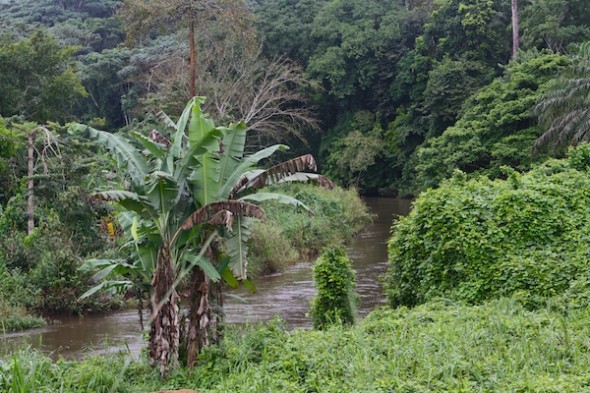
Vulnerable to dangerous spills: The Chad-Cameroon pipeline crosses a number of rivers in remote, densely forested areas. Photo: Christiane Badgley
The New York Times Green Blog reports on a new pipeline study from the U.S. National Wildlife Federation (NWF).
Times reporter Dan Frosch writes that the NWF study, “asserts that federal laws regulating oil pipelines are inadequate in several crucial areas and that local regulations do not provide sufficient protection against safety and environmental risks.”
The NWF report was prompted by a July 2010 rupture of an Enbridge Energy Partners oil pipeline in Michigan that spilled some 1 million gallons of crude oil, contaminating more than 30 miles of a major Lake Michigan truibutary. According to NWF, the incident, “raised health concerns and killed wildlife. It also exposed numerous weaknesses in pipeline regulation.
“The Enbridge oil spill is one of several recent high-profile oil pipeline disasters—from the Yellowstone River spill to the contamination of Red Butte Creek in Salt Lake City—that illustrate the risks posed by pipelines in communities across the country. Nationally, over the last 5 years, there have been over 1,700 spills from hazardous liquid pipelines causing more than $1.4 billion in property damage.”
The NWF focuses on the Michigan disaster and existing laws in the Great Lakes states, but a similar lack of oversight and regulation came to light after the ExxonMobil pipeline that crosses the Yellowstone River in Montana ruptured last July.
At that time, I asked if the Montana spill had lessons for Cameroon. The current report points to a number of issues that also concern the Chad-Cameroon pipeline, such as the insufficient assessment of long-term environmental risk and the need for more stringent monitoring, especially of pipelines that pass under lakes or rivers.
The Chad-Cameroon pipeline passes under multiple rivers, of course, and several of my sources have alleged that automatic shut-off valves are missing at a number of the river crossings. When the Lom Pangar dam is completed, an additional 25 km of the pipeline will be submerged.
The NWF report speaks of too much discretion left to the operators. This is certainly the case in Chad and Cameroon, where ExxonMobil (TOTCO/COTCO) monitors all aspects of the pipeline with little or no oversight. In Cameroon, the pipeline crosses remote forest areas that are pretty much inaccessible during the rainy season. Although ExxonMobil may be able to rapidly dispatch a helicopter to a remote spill site, getting clean up operations going is a completely different matter.
